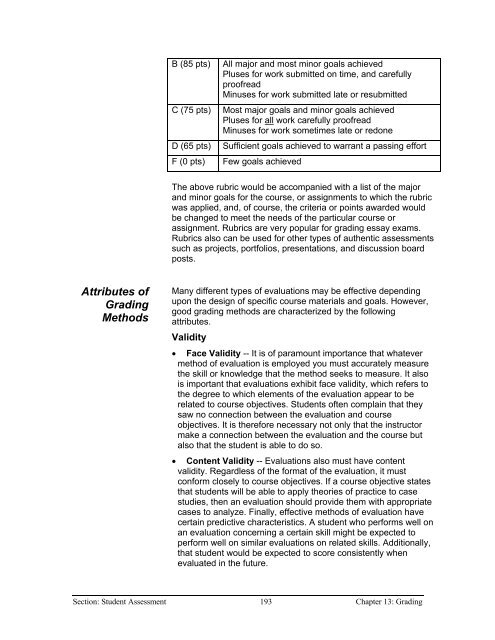Chapter 9 - Instructional Media: Chalkboards to Video - CGISS
Chapter 9 - Instructional Media: Chalkboards to Video - CGISS
Chapter 9 - Instructional Media: Chalkboards to Video - CGISS
You also want an ePaper? Increase the reach of your titles
YUMPU automatically turns print PDFs into web optimized ePapers that Google loves.
B (85 pts)<br />
C (75 pts)<br />
D (65 pts)<br />
F (0 pts)<br />
All major and most minor goals achieved<br />
Pluses for work submitted on time, and carefully<br />
proofread<br />
Minuses for work submitted late or resubmitted<br />
Most major goals and minor goals achieved<br />
Pluses for all work carefully proofread<br />
Minuses for work sometimes late or redone<br />
Sufficient goals achieved <strong>to</strong> warrant a passing effort<br />
Few goals achieved<br />
The above rubric would be accompanied with a list of the major<br />
and minor goals for the course, or assignments <strong>to</strong> which the rubric<br />
was applied, and, of course, the criteria or points awarded would<br />
be changed <strong>to</strong> meet the needs of the particular course or<br />
assignment. Rubrics are very popular for grading essay exams.<br />
Rubrics also can be used for other types of authentic assessments<br />
such as projects, portfolios, presentations, and discussion board<br />
posts.<br />
Attributes of<br />
Grading<br />
Methods<br />
Many different types of evaluations may be effective depending<br />
upon the design of specific course materials and goals. However,<br />
good grading methods are characterized by the following<br />
attributes.<br />
Validity<br />
• Face Validity -- It is of paramount importance that whatever<br />
method of evaluation is employed you must accurately measure<br />
the skill or knowledge that the method seeks <strong>to</strong> measure. It also<br />
is important that evaluations exhibit face validity, which refers <strong>to</strong><br />
the degree <strong>to</strong> which elements of the evaluation appear <strong>to</strong> be<br />
related <strong>to</strong> course objectives. Students often complain that they<br />
saw no connection between the evaluation and course<br />
objectives. It is therefore necessary not only that the instruc<strong>to</strong>r<br />
make a connection between the evaluation and the course but<br />
also that the student is able <strong>to</strong> do so.<br />
• Content Validity -- Evaluations also must have content<br />
validity. Regardless of the format of the evaluation, it must<br />
conform closely <strong>to</strong> course objectives. If a course objective states<br />
that students will be able <strong>to</strong> apply theories of practice <strong>to</strong> case<br />
studies, then an evaluation should provide them with appropriate<br />
cases <strong>to</strong> analyze. Finally, effective methods of evaluation have<br />
certain predictive characteristics. A student who performs well on<br />
an evaluation concerning a certain skill might be expected <strong>to</strong><br />
perform well on similar evaluations on related skills. Additionally,<br />
that student would be expected <strong>to</strong> score consistently when<br />
evaluated in the future.<br />
Section: Student Assessment 193 <strong>Chapter</strong> 13: Grading
















